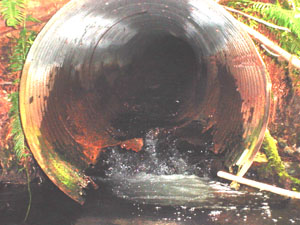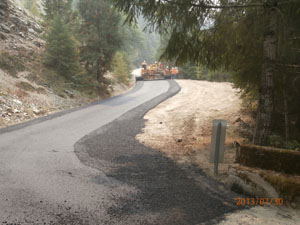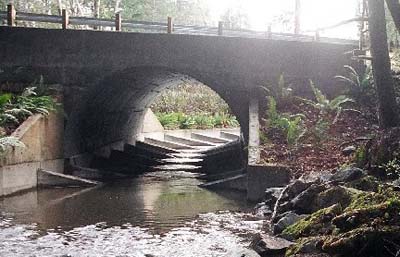|
Del Norte County Project News
In this issue:
Griffin Creek Sediment Reduction Project 1/23/14
 This project aimed to enhance water quality and improve salmonid habitat in the Griffin Creek and Middle Fork Smith River watersheds by implementing cost-effective sediment reduction treatment at the highest priority County road-related sediment source site on Oregon Mountain Road . This project aimed to enhance water quality and improve salmonid habitat in the Griffin Creek and Middle Fork Smith River watersheds by implementing cost-effective sediment reduction treatment at the highest priority County road-related sediment source site on Oregon Mountain Road .
This road treatment is expected to prevent at least 3,660 cubic yards of road fill related sediment from reaching tributary streams to Griffin Creek. An undetermined quantity of addition sediment would be anticipated from channel scour resulting from a catastrophic failure of the road crossing. In fact this crossing was considered to be in imminent danger of failure due to its rotted bottom condition and plug potential. Repeated plugging in the past has occurred at the inlet and stream flow has been observed to flow through the road fill creating sediments.
Four Sediment Reduction Projects 1/23/14
This project seeks to improve road surfaces in order to increase public access, improve safety for the motoring public, and to reduce road-related dust and sediment generation. The Patrick’s Creek Road and Old Gasquet Toll Road provide vital access to the regional electrical transmission lines and all of the road segments provide access to federal lands used for hiking, hunting, and other recreational land uses as well as for forest and fire management activities. French Hill Road also provides access to several residential parcels.
 Prior to project completion, four of the road surfaces were unpaved, while the chip seal on Patrick’s Creek Road’s pavement was so deteriorated that surface wear, erosion, sediment transport to ditches, and/or mobilization of road dust were readily observable. Prior to project completion, four of the road surfaces were unpaved, while the chip seal on Patrick’s Creek Road’s pavement was so deteriorated that surface wear, erosion, sediment transport to ditches, and/or mobilization of road dust were readily observable.
The project consisted of the design, layout, environmental compliance (NEPA and permitting), and implementation of triple chip sealing of 2.25 miles of Patrick’s Creek Road and asphalt-concrete (AC) road surfacing of approximately one mile of the other County roads. All work was done on road segments near, or at, stream crossing where there is the greatest potential for road surface erosion to deliver to a stream. All work was done by the Del Norte County Road Division between July and October, 2013.
The road surfacing project is expected to prevent at least 1,525 cubic yards of road surface erosion per decade. The project will reduce airborne particulates associated with road dust on all 3.25 miles of treated roads. The improved air quality is most beneficial on French Hill Road and Patrick’s Creek Roads where residences and a lodge are located. The project improves traffic safety by eliminating uneven road surfaces (“washboarding”) and increasing sighting distances that are affected from dust. The project reduces Del Norte County’s Road Division maintenance costs associated with frequent road blading and use of dust control palliatives or enzymes for dust control.
This project was a partnership of 5C, the Del Norte County Community Development and Six River National Forest Resource Advisory Council.
Peacock Creek Project earns CELSOC Award 10/31/11
Del Norte County's Peacock Creek Fish Passage project won an Honor Award in the Environmental Category of CELSOC's 2005 Engineering Excellence Award competition. This is a state-wide award by the Consulting Engineers and Land Surveyors of California (CELSOC).
Steven Allen of Winzler & Kelly assisted the County Engineer with this project from the start, helping to write the grants to receive funding through the Department of Fish & Game, designing the project and managing the overall engineering design effort, assisting with the construction phase, and coordinating the application process with CELSOC. Steve was the project manager for the design team which also included Michael Love & Associates for the hydrology and fish passage design aspects and Taber Consultants for the geotechnical investigation.
This successful project was the result of a collaborative team effort between the County Community Development Department, the Department of Fish & Game, the Coastal Conservancy, Winzler & Kelly Consulting Engineers, and the County Road Division that built the project with assistance from Hemmingson Construction Company for the concrete work and the California Conservation Corps providing the revegetation.
Both the County Engineer and Mark Lancaster, Program Manager of the Five Counties Salmonid Conservantion Program attended the award ceremony with Steven Allen and Michael Love in Sacramento on Monday January 24th.
Peacock Creek Project Completed in 2005
The Peacock Creek Project was to improve fish passage conditions on Peacock Creek by removing the existing County culvert and replacing it with a 20-foot wide by 140-foot long pool and weir fishway partially covered by a structural steel plate arch. The structure is designed to provide upstream passage for juvenile and adult migration cutthroat and steelhead trout, and coho and chinook salmon. The project is approximately 4,000 feet upstream of the confluence with the Smith River, which is an un-dammed pristine watershed with healthy anadromous fish populations. Completed in November of 2003, the new fishway provides fish access to over 3,500 feet of upstream habitat.
The County of Del Norte obtained funding for the project through the California Department of Fish and Game’s Grants Program and through the California Coastal Conservancy. Winzler & Kelly Consulting Engineers and Michael Love & Associates were selected to develop a design suitable for the site.
The County maintained stream crossing on Peacock Creek was a severe barrier to all salmonids. The crossing consisted of a steep and undersized culvert that was perched about 3.5 feet above the downstream channel. Physical site constraints included 7 feet of vertical drop over 80 feet of channel length, water intake wells approximately 70 and 110 feet upstream of the existing culvert inlet, State Parks land immediately downstream, the CalTrans Highway 197 road prism adjacent to the site, and another CalTrans culvert only 400 feet upstream. Although the upstream culvert currently provides passage, any headcutting and incision of the downstream channel could make the crossing a barrier and risk structural failure of the crossing. These constraints necessitated an alternate design solution.

The resulting design is a fishway resting on concrete strip footings connected by struts, allowing an open bottom structure. An innovated concrete “vortex weir” design is used with the intention of creating ideal conditions for upstream migrating juvenile salmonids. This weir shape also allows for the fishway to function over a wider range of flows and will better concentrate the plunging flow to increase scouring and avoid having the pools fill with sediment. The vortex weirs are 20 feet wide and spaced 10 feet apart, with 8 inch drops over each weir. To ensure that the downstream end of the fishway remains backwatered by the channel, a downstream boulder grade control weir was built into the channel bed. Observations were made throughout its first winter of operation, which included a flow exceeding bankfull. Qualitative results show good flow patterns over the vortex weirs, and resting pools remain sufficiently scoured.
Back to news index.
For more information contact us
The 5C Enews is funded through the Fisheries Restoration Grant Program through the CA Department of Fish and Wildlife
Image of Chinook Fry at top of page courtesy of USFWS & Dan Cox
| 